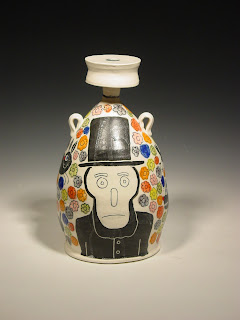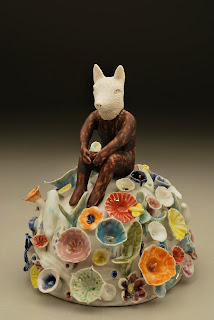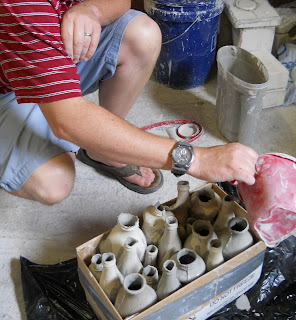 |
| All Aboard |
 |
| All Aboard, Detail |
Peter Morgan's Fellowship Exhibition, 'All Aboard' has just come down at the Clay Studio of Philadelphia and I had a chance to ask him some questions about his ideas and this work in particular. I've known Peter since we taught at Cal State Long Beach together and shared a studio. He is entertaining as always. I've included some of my favorite past works by Peter along with this interview. More images of this exhibition can be seen on an earlier blogpost or at the Clay Studio website.
I know that in much of your work you create a series within
a theme or set of parameters, like your black and white animals series or the
historical naval battle from the civil war. For this installation, All Aboard,
what is the underlying theme or logic that ties together these images?
This work is a bit of
conceptual departure from some of those other pieces that needed all the parts
to be complete. The format of a
train car allowed me to pursue a lot of different ideas. All kinds of things need to be transported,
so that opened up what I could make.
In some ways this work is much more personal than the previous pieces
you are referencing. I could
really pick and choose things that I am like or find intriguing.
Do you think people enjoy real experiences of place or
simulated ones?
Both, sure it is fun to
see the Parthenon in Greece, but it is also fun to see the reproduction in
Nashville. They are not the same
experience, but people can enjoy both.
Do you think there is such a thing of an authentic
experience of place?
Of course, I am not sure
what an unauthentic experience would be.
I was reading about Tom’s shoes the other day, and how Tom or whatever
the guys name was that founded the company, went to south America, saw kids
without shoes and he had an “authentic experience” That got me wondering what
an unauthentic experience would be.
Sure we have lots of different experiences, and they but they are all
“authentic” to us in their own way.
I like the analogy you make in your artist statement between
how people bring model train sets to life through the suspension of disbelief
and your works about place. How do
you think this functions in your work?
Oh, yes. I do need to
write a new artists statement, that thing is old, but writing a new one is an
irksome task. I was thinking
of a whole train set up with buildings, tunnels, trees, etc… but I guess that could work in
this instance. Perhaps a better
example of the “suspension of disbelief” in my recent work would be the puffin
colony I made this past winter. There
was a large enough volume of puffins, doing different things and interacting
with each other where the viewer could get lost in the piece and not really
think about being in a gallery etc...
That piece also had a sound component of a puffin colony, which played
in the background and also aided this “suspension of disbelief”
This work in particular is very detailed, but still very toy
like with regards to scale. How do
you decide what to include and how to make the pieces just detailed enough to
be believable?
If you look closely at
trains, you can see that there are all kinds of things that I left out. I felt that I needed to have a good
grasp of the shape of the cars, and get some of the details, (like the
corrugation on the ends of the boxcars) so that it looked like I knew what I
was doing. The pieces are more
complex then their basic forms, but a lot of components did not translate well
to ceramics.
For instance, I left out
the couplers, that connect the train cars, I could have added them but they would not have connected,
and would have looked kind of stupid when they were all lined up. In that case I just allow the viewers
mind to fill in the gaps and pretend that the train cars are being pulled by the
locomotive.
Humor is a strong element in your work. In fact I don’t know if I’ve seen work
of yours without humor. Why is
this important to you and how does it inform the way you often critique cliché’
symbols of meaning?
You think my work is humorous?
 |
| Sky Mall Exclusives |
Is this funny?
 |
| Detail, Sky Mall Exclusives |
For me one of the functions of art is to make us look at the
world we take for granted in a different way. This work seems to combine the
mundane with the fantastical. Is
this something you think about?
Are you interested in the idea of the mundane or ordinary or is this an
expression of a personal iconography of sorts?
I do like the idea of the
mundane, I had a big idea years ago that I would only make boring things. It came from a question of why do we
want to make exciting things, and then what would be the opposite of that? There is something I like about the accessibility of the
mundane, it is a way that a lot of people find an entry point into the
work. I don’t know if I would go
as far to call it a personal iconography, but we will see. I could be known as the mundane
guy. “Oh you know Peter Morgan,
that guy is so mundane” I suppose
that would be better then being banal.
If you are into the banal then you are probably trying too hard.
How did you come to this idea? Were the train cars originally individual ideas or was the
train the catalyst for creating the series?
I had wanted to make a train for a
long time, but I never was quite sure how to construct it, or how to display
it. In March I was in a show in
Virginia and I made three train cars based upon donuts, or transporting donut
related products. I made a
small trestle for that piece that was based upon trestles where I grew up. That piece seemed fairly successful,
but there was clearly more that I could do with it.
The nice thing about the train, is
that each car is kind of a tabula rasa. So many things, need to
be transported, so it could be easy just to put anything on a flat bed train
car, a giant buffalo or watermelon, etc… I took my cues from a few different places. Some of the train cars are based upon
real train cars that struck my fancy in some way. Like the Tropicana car, for example, I drink a lot of orange
juice and have always been a fan of their train cars that are used to transport
juice from Florida to all over the country. Some of them I would use historical “rolling stock”
and give it a twist, like the Plutonium car is based upon old dairy cars.
Others are based upon some Lionel train cars,
like the trout transport, and the bourbon car. I don’t think that Lionel had a bourbon car, but they did
have barrel transport cars, and I am a bit of a bourbon aficionado so I tweaked
the car to personalize it a bit.
On a few cars, like the Sinclair Dinosaur and the Loon, I took iconic imagery
and put them on a flat bed car.
The loon is based on a large sculpture in Mercer, WI. Mercer is that is apparently the “loon
capital of the world” and is home to “Claire de Loon” which is the world’s
third largest loon.
I see that you have drawings with the show online, were
these in response to the work, or were they generated first while you were
creating the ideas for each car?
The drawings were done
after the pieces were completed, or nearly completed, otherwise I wouldn’t know
how to draw them.
Do you have any thoughts as to your use of material and any
relationship between material/process and your concept?
Nope, I have never thought
about it. Well not is not exactly
the case but perhaps I should be a real snob in this interview. Primarily I am a ceramicist, and that
is where I start with my pieces.
There are some things that clay does really well, and other things that
it does not. For the train piece,
I realized that I needed a trestle, and I could have made some manner of bridge
out of clay, but it would have been super heavy, expensive, and visually very
heavy. Making it out of wood gives
the piece a bit of realism, and is fairly light, and movable, and references
real train trestles out in the world.
So it becomes a bit of a salute to the engineers who figured out how to
make bridges and such.
What do you think your next project might be? I know you are involved in founding a
gallery in Philadelphia.
I am not entirely sure
what will be next, I have a few thematic exhibitions coming up this spring that
I am working towards, but I would like to do a larger series of birds akin to
Audubon’s Birds of North America. I am also looking at putting out my
first through 15th rap album.
Yes, I am part of a gallery here in
Philadelphia called Practice, that got started back in August. There are six of us involved in with
the space, and it is in a building that houses several other artist run
spaces. That way we get a lot of
foot traffic and don’t have to lure people to come to a new out of the way
space. It has been an interesting
experience, working with people with a lot of different ideas about art how to
use the space. I am more of the
“traditionalist” in the group. We
tend to exhibit more “experimental” works involving performance or perhaps
“installation” but I will put my foot down if people want to do any
“relational” projects.
Right now we have a Cat Show. We asked artists from all over to send
us a cat. This is our big fundraiser,
so we can build a closet, refinish the floors in the space, and of course put
on future exhibitions. Perhaps we
could get a chair and desk for the gallery sitter.
 |
| Peter Morgan |






















































